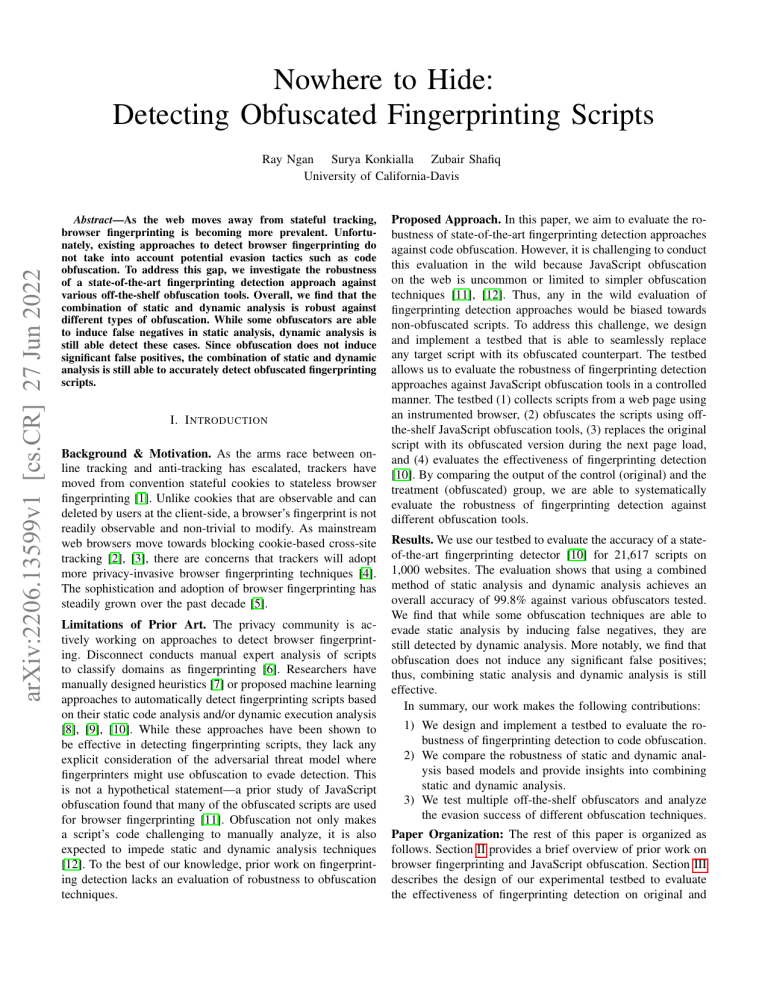Detecting Obfuscated Fingerprinting Scripts: A Robust Analysis
advertisement

Nowhere to Hide:
Detecting Obfuscated Fingerprinting Scripts
arXiv:2206.13599v1 [cs.CR] 27 Jun 2022
Ray Ngan Surya Konkialla Zubair Shafiq
University of California-Davis
Abstract—As the web moves away from stateful tracking,
browser fingerprinting is becoming more prevalent. Unfortunately, existing approaches to detect browser fingerprinting do
not take into account potential evasion tactics such as code
obfuscation. To address this gap, we investigate the robustness
of a state-of-the-art fingerprinting detection approach against
various off-the-shelf obfuscation tools. Overall, we find that the
combination of static and dynamic analysis is robust against
different types of obfuscation. While some obfuscators are able
to induce false negatives in static analysis, dynamic analysis is
still able detect these cases. Since obfuscation does not induce
significant false positives, the combination of static and dynamic
analysis is still able to accurately detect obfuscated fingerprinting
scripts.
I. I NTRODUCTION
Background & Motivation. As the arms race between online tracking and anti-tracking has escalated, trackers have
moved from convention stateful cookies to stateless browser
fingerprinting [1]. Unlike cookies that are observable and can
deleted by users at the client-side, a browser’s fingerprint is not
readily observable and non-trivial to modify. As mainstream
web browsers move towards blocking cookie-based cross-site
tracking [2], [3], there are concerns that trackers will adopt
more privacy-invasive browser fingerprinting techniques [4].
The sophistication and adoption of browser fingerprinting has
steadily grown over the past decade [5].
Limitations of Prior Art. The privacy community is actively working on approaches to detect browser fingerprinting. Disconnect conducts manual expert analysis of scripts
to classify domains as fingerprinting [6]. Researchers have
manually designed heuristics [7] or proposed machine learning
approaches to automatically detect fingerprinting scripts based
on their static code analysis and/or dynamic execution analysis
[8], [9], [10]. While these approaches have been shown to
be effective in detecting fingerprinting scripts, they lack any
explicit consideration of the adversarial threat model where
fingerprinters might use obfuscation to evade detection. This
is not a hypothetical statement—a prior study of JavaScript
obfuscation found that many of the obfuscated scripts are used
for browser fingerprinting [11]. Obfuscation not only makes
a script’s code challenging to manually analyze, it is also
expected to impede static and dynamic analysis techniques
[12]. To the best of our knowledge, prior work on fingerprinting detection lacks an evaluation of robustness to obfuscation
techniques.
Proposed Approach. In this paper, we aim to evaluate the robustness of state-of-the-art fingerprinting detection approaches
against code obfuscation. However, it is challenging to conduct
this evaluation in the wild because JavaScript obfuscation
on the web is uncommon or limited to simpler obfuscation
techniques [11], [12]. Thus, any in the wild evaluation of
fingerprinting detection approaches would be biased towards
non-obfuscated scripts. To address this challenge, we design
and implement a testbed that is able to seamlessly replace
any target script with its obfuscated counterpart. The testbed
allows us to evaluate the robustness of fingerprinting detection
approaches against JavaScript obfuscation tools in a controlled
manner. The testbed (1) collects scripts from a web page using
an instrumented browser, (2) obfuscates the scripts using offthe-shelf JavaScript obfuscation tools, (3) replaces the original
script with its obfuscated version during the next page load,
and (4) evaluates the effectiveness of fingerprinting detection
[10]. By comparing the output of the control (original) and the
treatment (obfuscated) group, we are able to systematically
evaluate the robustness of fingerprinting detection against
different obfuscation tools.
Results. We use our testbed to evaluate the accuracy of a stateof-the-art fingerprinting detector [10] for 21,617 scripts on
1,000 websites. The evaluation shows that using a combined
method of static analysis and dynamic analysis achieves an
overall accuracy of 99.8% against various obfuscators tested.
We find that while some obfuscation techniques are able to
evade static analysis by inducing false negatives, they are
still detected by dynamic analysis. More notably, we find that
obfuscation does not induce any significant false positives;
thus, combining static analysis and dynamic analysis is still
effective.
In summary, our work makes the following contributions:
1) We design and implement a testbed to evaluate the robustness of fingerprinting detection to code obfuscation.
2) We compare the robustness of static and dynamic analysis based models and provide insights into combining
static and dynamic analysis.
3) We test multiple off-the-shelf obfuscators and analyze
the evasion success of different obfuscation techniques.
Paper Organization: The rest of this paper is organized as
follows. Section II provides a brief overview of prior work on
browser fingerprinting and JavaScript obfuscation. Section III
describes the design of our experimental testbed to evaluate
the effectiveness of fingerprinting detection on original and
obfuscated scripts. We present the results and analysis in
Section IV before concluding in Section V with an outlook
to future work.
B. JavaScript Obfuscation
Obfuscation aims to decrease the understandability of code
while retaining its functionality. The code undergoes a series
of transformations that make it harder to comprehend and analyze [19]. The types of transformations vary across different
obfuscation tools, which may open-source or proprietary. Web
developers typically use these obfuscation tools to disguise
the intent of their code and prevent unauthorized copying and
modification [20]. Obfuscation is also known to be used by
web-based malware to hide the malicious intent of JavaScript
code.
An obfuscator usually applies several transformations, so it
is important to consider the effect of each one. An obfuscation
technique typically changes a program in one or more of
the following areas: control flow, data structures, and layout
[19]. Techniques that target control flow involve reconstructing
a program’s functions and loops in a way that makes the
program harder to follow. Some control flow transformations
have the potential to impede dynamic analysis. For example,
dummy code injection inserts irrelevant computations into
the program, obscuring the resulting execution trace (while
preserving the program’s original functionality). Data structure
transformations include variable encoding and encryption. Finally, layout transformations focus on decreasing information
available to those reading the code. These include removing
comments, renaming identifiers, and disrupting the formatting.
The most effective obfuscators combine techniques from multiple categories.
Obfuscators often perform minification as well. Minification compacts code to reduce load times and improve user
experience. Minification tools typically remove whitespace and
shorten variable/function names. While it has a different goal
than obfuscation, minification also reduces the legibility of
code, but to a lesser extent.
Recent web measurements of JavaScript obfuscation have
reported that certain techniques are far more prevalent than
others. Skolka et al. [11] built a series of machine learning
classifiers to detect obfuscated/minified scripts and used it to
study JavaScript obfuscation on top-100k websites. The first
phase of their study focuses on the prevalence of obfuscation/minified among the scripts collected from these sites. The
application of their classifiers showed that minification was far
more common than obfuscation. Specifically, they found that
minification was used by 38% of the analyzed scripts while
less than < 1% of the encountered scripts were obfuscated.
The authors then analyzed these obfuscated scripts in the
next phase of their study. They created classifiers to detect
obfuscation done by each of the following tools: javascriptobfuscator, DaftLogic, jfogs, javascriptobfuscator.com, and
JSObfu. DaftLogic obfuscation was detected in nearly 90%
of the obfuscated scripts. The authors noted that DaftLogic is
the only obfuscator among these five that encodes the entire
code using eval. The authors concluded that eval based
obfuscation is the most commonly used obfuscation technique
among the detected obfuscated scripts.
II. BACKGROUND & R ELATED W ORK
A. Browser Fingerprinting
Browser fingerprinting is a stateless web tracking technique.
To build a browser’s fingerprint, a fingerprinting script combines information gathered from HTTP headers and Web APIs
via JavaScript [1]. While this fingerprint is not guaranteed to
be unique or persistent [1], browser fingerprinting provides
certain advantages as compared to cookies. A cookie-based
approach is stateful; the server typically sets the cookie and
the browser sends the cookie to the server from the browser’s
cookie jar for all subsequent requests to the server. Note that
a user can easily remove this cookie from the browser. On the
other hand, browser fingerprinting is stateless in that it does not
require storing any state at the client-side. The stateless nature
of browser fingerprinting means that it is less transparent and
more difficult to control (e.g., remove or modify) as compared
to cookies.
The research community has been investigating browser
fingerprinting techniques and their deployment in the wild
over the last decade or so [1], [5], [10], [13], [14], [15], [16],
[9], [8], [7], [17], [18]. Prior work has manually designed
heuristics to detect specific types of browser fingerprinting
(e.g., canvas, font, WebGL, AudioContext, Battery Status)
[14], [7], [18]. More recently, researchers have employed static
and/or dynamic analysis techniques with machine learning for
automated detection of browser fingerprinting [10], [8], [9].
For example, Bird et al. used semi-supervised learning to
detect fingerprinting scripts based on the similarity of their
execution patterns to known fingerprinting scripts [8].
Most recently, Rizzo et al. [9] and Iqbal et al. [10] used
supervised learning models to detect fingerprinting scripts
based on static and dynamic analysis. Static analysis captures
the content and structure of the scripts that may not be executed when visiting the sites. Dynamic analysis captures the
execution traces that include information about API accesses
by the script. The final decision is made by combining the
classification results of the static and dynamic machine learning models. Therefore, a script is detected as fingerprinting if
it is classified as such by either the static analysis model or
the dynamic analysis model. Combining static and dynamic
analysis, F P -I NSPECTOR [10] achieved the state-of-the-art
99.9% accuracy. While dynamic analysis is expected to be
able to better handle the use of obfuscation by fingerprinters
as compared to static analysis [9], [10], it is noteworthy that
prior work lacks any (systematic or anecdotal) evaluation
of the impact of code obfuscation on the performance of
static or dynamic analysis. Furthermore, prior work lacks any
evaluation of whether combining static and dynamic analysis
is effective at improving detection accuracy of obfuscated
fingerprinting scripts.
2
More recently, Sarker et. al [12] leveraged the discrepancy
between static and dynamic analysis outputs to detect code
obfuscation. Using this approach, they studied JavaScript
obfuscation on the top-100k website. They also analyzed
popular JavaScript obfuscation techniques in the wild. The
authors concluded that eval is no longer the most popular
obfuscation technique on the web. They further identified
five other commonly used obfuscation techniques. The most
common technique in this group is “Functionality Map”,
which involves taking all of the script’s invocations in string
literal form and placing them in an array. In some cases, the
array may be rotated. An “accessor” function may also be
used rather than direct array indices; this function generates
the invocation’s index based on the given argument(s). The
obfuscation technique shown in Figure 3 is a simplified
variation of a functionality map. “Table of Accessors” uses a
decoder function that maps encoded strings to function names
and property accesses. Each function and property access is
associated with a specific call to the decoder function. All of
these calls are placed into an array and accessed accordingly.
The technique “Coordinate Munging” uses wrapper functions
to perform API calls and property accesses; each invocation is
associated with an identifier that must be passed to the wrapper
function. Similarly, “Classic String Constructor” uses decoder
functions to map a given number to a string literal. “Switchblade Function” involves a switch-case function, which returns
a wrapper function that corresponds to the requested invocation. The switch statement may further contain nested switch
statements.
However, our instrumentation is not able to capture inlined
scripts that are directly embedded in the main HTML using
the <script> tag.1 This set of scripts serve as our control
group.
C. Script obfuscation
We then obfuscate these code snippets using a set of off-theshelf JavaScript obfuscation tools. Since we need to obfuscate
a large number of scripts, we implemented an automation
script for each obfuscator. Some obfuscators have a command
line interface which makes the automation. Other obfuscators
that have a web-based interface are automated using Selenium
[22]. This obfuscated set of scripts serves as the treatment
group.
D. F P -I NSPECTOR
We briefly describe the details of F P -I NSPECTOR’s static
and dynamic analysis models [10] and how we use them in
our testbed.
1) Static Analysis: The static analysis component of F P I NSPECTOR focuses on the content and structure of the
JavaScript code snippet rather than its execution. Given a
script, F P -I NSPECTOR begins by building an Abstract Syntax
Tree (AST), where the nodes represent keywords, identifiers,
and literals and the edges represent the dependencies between
them. F P -I NSPECTOR then traverses the AST and extracts
features. A decision tree model uses these features to classify
the script as fingerprinting or non-fingerprinting.
To evaluate the static analysis model on control and treatment groups, we run static analysis on a set of scripts and
their obfuscated variants, and then analyze whether their
classifications outcomes differ. If F P -I NSPECTOR classifies
a script as fingerprinting and the obfuscated version as
non-fingerprinting, we conclude that obfuscation induced a
false negative. If F P -I NSPECTOR classifies a script as nonfingerprinting and the obfuscated version as fingerprinting, we
conclude that obfuscation induced a false positive.
2) Dynamic Analysis: Different from static analysis, the
dynamic analysis component of F P -I NSPECTOR leverages
JavaScript execution to capture the API calling frequency
and the higher level semantics. We expect dynamic analysis
to be more robust against obfuscated scripts, since it can
extract relevant features from the execution traces while static
analysis cannot. To evaluate the dynamic analysis model on
control and treatment groups, we modify F P -I NSPECTOR’s
implementation as follows.
To seamlessly replace original scripts with their obfuscated
versions during a web page load, we use a modified version
of OpenWPM [21] and mitmProxy [23]. Figure 2 shows the
process of replacing original scripts with the corresponding
obfuscated scripts on the fly. mitmProxy allows us to transparently intercept HTTP requests and modify HTTP responses
in real time. We can then map original and obfuscated scripts
III. P ROPOSED A PPROACH
A. Overview
We aim to investigate the impact of different JavaScript
obfuscation techniques on the accuracy of static and dynamic
analysis based fingerprinting detection approaches. To this end,
we design and implement a testbed to collect scripts on a
webpage using an instrumented browser, obfuscate them using
various off-the-shelf JavaScript obfuscation tools, replace the
original scripts with their obfuscated versions, and evaluate
FP-I NSPECTOR’s static and dynamic analysis classifiers. First,
we use OpenWPM [21] to crawl through a list of web pages
and collect the sources of JavaScript code snippets. Second, we
use various off-the-shelf obfuscators to obfuscate the collected
scripts. The original, presumably non-obfuscated, scripts will
be used as our control group and obfuscated scripts will serve
as our treatment group. Third, we reload the web pages in
both control and treatment (i.e., replace original scripts with
their obfuscated versions) settings. Finally, we evaluate static
analysis and dynamic analysis classifiers of FP-I NSPECTOR
[10] in both control and treatment groups.
B. Script collection
We use OpenWPM to automatically crawl web pages and
collect scripts from them. Our OpenWPM instrumentation is
able to collect the embedded scripts that are referenced in the
HTML using the “src” (source) attribute in <script> tags.
1 Note that Iqbal et al. [10] reported that inlined fingerprinting scripts are
relatively uncommon. Less than 3% of the detected fingerprinting scripts in
their dataset were inlined.
3
Treatment Group
Static Analysis
FP
Source Files
Source Files
Logging
Logging
FP Inspector
NFP
JavaScript
Control Group
Dynamic Analysis
(1) Opening websites with OpenWPM
instrumented Firefox and collecting scripts
(2) Obfuscating scripts using
various obfucators
(3) Feeding in data to FP-inspector's
Static Analysis and Dynamic Analysis
(4) Classifying scripts to fingerprinting
and non-fingerprinting for
treatment and control group
Fig. 1: Overview of our evaluation approach: (1) We crawl web pages with an extended version of OpenWPM that extracts
JavaScript source files and their execution traces. (2) The original JavaScript source files serve as the control group. To generate
the treatment group, we pass the JavaScript source files to different obfuscators. (3) We pass the both the control group and
treatment group to F P -I NSPECTOR’s static analysis and dynamic analysis components. (4) We take F P -I NSPECTOR’s results
and identify which classifications varied across the control group and treatment group.
Obfuscated
Scripts
Source Files
Source Files
Logging
Logging
Replacement
Process
match not found
match found
JavaScript
Server
Collected Obfuscated
Script
Script
match not found
mitmProxy
(1) Opening websites with
OpenWPM and fetching JavaScript
using mitmProxy
(2) Intercepting JavaScript on the
fly and replacing collected scripts
and obfuscated scripts if matched
(3) Relaying JavaScript to
intended server if no matched
obfuscated script is found
Fig. 2: On-the-fly replacement of obfuscated versions of the
scripts in the treatment group: (1) While visiting a web
page using OpenWPM, we intercept HTTP requests to fetch
JavaScript using the mitmProxy. (2) If the script URL of an
intercepted HTTP request matches that of an obfuscated script,
mitmProxy returns the obfuscated script as the HTTP response
payload. (3) If there is no match, then the HTTP request is
relayed to the intended server to fetch the original script.
content dynamically; i.e., the same web page may request a
different set of scripts when it is loaded in separate browser
instances even if the page load time is perfectly synchronized.
As a result, each of our proxies may intercept a different
number of scripts, despite the fact that they are running
concurrently. To mitigate the issue of differing scripts across
different browser-proxy instances, we decide to discard sites
that could not find replacement scripts across at least 80%
of obfuscators. While this is not guaranteed to completely
eliminate the issue, we limit our analysis to the overlapping set
of scripts that is successfully obfuscated and replaced across
all browser-proxy instances.
To evaluate the dynamic analysis model on control and
treatment groups, we run dynamic analysis on execution traces
of original scripts and their obfuscated variants, and then
analyze how their classification outcomes differ. Similar to
static analysis evaluation, we record both false negatives and
false positives by comparing the classification of original and
obfuscated scripts.
IV. E XPERIMENTAL E VALUATION
A. Data
1) Data Collection: We crawl the list of web pages reported
by [10] to contain fingerprinting scripts. These web pages
represent an approximately 10% subset of the top-10K sites
and a random sample of 10K sites ranked between 10K and
100K [24]. We re-crawl these web pages and again use F P I NSPECTOR to classify the collected scripts as fingerprinting or
non-fingerprinting. We crawled a total of 1,000 sites from [24].
F P -I NSPECTOR classified 543 scripts as fingerprinting and
21,074 scripts as non-fingerprinting on these sites. Overall,we
find that 421 sites (42%) still contain at least one fingerprinting
script and 579 sites (58%) contain only non-fingerprinting
scripts.
based on their script URL and content hash and use them to
make appropriate replacements during the page reload. Note
that we run multiple proxy instances alongside OpenWPM
concurrently, one proxy instance for the control group and
one proxy instance corresponding to each obfuscated variant
in the treatment group, to minimize temporal differences in the
control and treatment settings. Each browser-proxy pair uses
a different port; the proxy listens to requests at the specified
port and replaces the scripts accordingly.
A challenge we face here is that web pages often load
4
2) Obfuscators: To generate the dataset of obfuscated
scripts, we choose four publicly available off-the-shelf
JavaScript obfuscators that implement a variety of code transformations. Javascript-obfuscator [20] and Google Closure
Compiler [25] are command line tools, while DaftLogic [26]
and BeautifyTools [27] have a web interface.
i) javascript-obfuscator: javascript-obfuscator is an opensource obfuscator (that also has a web-based version named
obfuscator.io). It includes four modes that apply varying
“degrees” of obfuscation. Note that this obfuscator applies
transformations in terms of AST nodes. A transformation
“threshold” indicates the probability that that transformation
will be applied to an AST node. For example, “medium”
has a 75% chance of applying control flow flattening to a
particular node, while “high” applies this transformation to all
nodes. “Simplify” compacts control structures by reducing the
number of branches. “Control Flow Flattening” replaces a program’s functions and loops with an infinite loop that contains
a switch statement. “String Array” indicates that javascriptobfuscator replaces strings with an array index (which is an
implementation of the “Functionality Map” technique discussed in Section II). Dead code injection involves adding
code that does not change the execution flow. Figure 4 shows
an example “Medium” obfuscated script.
ii) Google Closure Compiler: Google Closure Compiler
is primarily used to minify code for the sake of improving
performance. We include this tool because it also implements
obfuscation techniques. As shown in Figure 6, Google Closure Compiler performs whitespace and comment removal on
JavaScript. It also performs optimizations within expression
and functions from JavaScript. This includes renaming local
variables and function parameter to shorter names.
iii) DaftLogic: DaftLogic has two goals: make code more
difficult to copy and paste and reduce script size to improve
performance. This obfuscator begins by removing line breaks
and comments. Then it applies a series of transformations,
as shown in Figure 5. We note that DaftLogic replaces
keywords and identifiers with string array indices, which is
an implementation of the “Functionality Map” technique, just
like “String Array” in javascript-obfuscator. DaftLogic also
encloses the code in an eval.
iv) BeautifyTools: BeautifyTools also uses eval and string
array indices. Unlike the other obfuscators, it can also accept
obfuscated input and undo the transformations. If the code
is obfuscated with the intent of deobfuscation later, the “Fast
Decode” option can be used to quicken the process. As shown
Figures 7 and 8, selecting “Fast Decode” will define the
functions beforehand. We use the “Fast Decode” option in
our study because we see it as the option that produces more
performant code. We assume that in a real use case, one would
want to balance the level of obscurity and performance. The
”Fast Decode” option helps find this balance.
(fingerprinting and non-fingerprinting), the confusion matrix is
divided into four categories: True Positive (correctly detected
fingerprinting script), True Negative (correctly detected nonfingerprinting script), False Positive (incorrectly detected nonfingerprinting script), and False Negative (incorrectly detected
fingerprinting script). Using this confusion matrix, we calculate F P -I NSPECTOR’s accuracy, false positive rate, and false
negative rate for each obfuscator and separately for static and
dynamic analysis classification models.
We discuss the importance of false negatives and false
positives below. Since a fingerprinter will attempt to obfuscate
its fingerprinting scripts to evade detection, its main goal is to
induce false negatives. In other words, a false negative would
indicate that the obfuscation was able to successfully manipulate F P -I NSPECTOR into classifying a fingerprinting script as
non-fingerprinting. While we do not expect non-fingerprinting
scripts to be obfuscated with the express purpose of evading
detection, they may be obfuscated for other benign reasons.
False positives would indicate that a non-fingerprinting obfuscated script is incorrectly classified as fingerprinting. These
false positives would result in detection and mitigation of
benign (i.e., non-fingerprinting) scripts, potentially breaking
site functionality.
C. Evaluation
Impact on obfuscators. Table I presents the combined
and individual results of static and dynamic models against
different obfuscators. Note that the combined method of both
static analysis and dynamic analysis produced an accuracy of
over 99% for all obfuscators. However, this does not necessarily mean that the obfuscation techniques did not impact
F P -I NSPECTOR. We note that BeautifyTools and DaftLogic do
impact the F P -I NSPECTOR’s static analysis. The accuracy of
static analysis model for both obfuscators is reduced to around
93%. Crucially, the false negative rate for both BeautifyTools
and DaftLogic are 100%, meaning that all of the obfuscated
fingerprinting scripts are classified as non-fingerprinting by
F P -I NSPECTOR’s static analysis classification model.
To understand why DaftLogic and BeautifyTools are particularly successful at evading static analysis, we investigate
the construction of static analysis. We find that DaftLogic and
BeautifyTools drastically shrink a script’s AST. Table II shows
one example of this case. This suggests that the efficacy of
static analysis in identifying fingerprinting scripts depends on
the richness of the AST. As previously mentioned, DaftLogic
and BeautifyTools are the only obfuscators in this study that
use eval for obfuscation. Thus, we conclude that eval based
obfuscation, which essentially converts the code to a string
form, disproportionately hinders the ability of static analysis
to extract useful features.
Impact on static vs. dynamic analysis. Table I, it also
shows that dynamic analysis performs better than static analysis against all obfuscators, especially for BeautifyTools and
DaftLogic. The overall accuracy of F P -I NSPECTOR’s dynamic
analysis model is around 99%. This is due to the fact that
dynamic analysis does not share static analysis’ struggles when
B. Evaluation Metrics
To evaluate F P -I NSPECTOR’s effectiveness, we use the
classification confusion matrix. Since we have two classes
5
Obfuscators
BeautifyTools
Google Closure Compiler
DaftLogic
Javascript-Obfuscator Default
Javascript-Obfuscator Low
Javascript-Obfuscator Medium
Javascript-Obfuscator High
FPR
0.0%
0.0%
0.0%
0.0%
0.2%
0.0%
0.2%
Combined
FNR
Accuracy
6.1%
99.5%
0.0%
100.0%
4.1%
99.7%
2.0%
99.8%
2.0%
99.7%
2.0%
99.8%
0.0%
99.8%
FPR
0.0%
0.0%
0.0%
0.0%
0.0%
0.2%
0.2%
Static Analysis
FNR
Accuracy
100.0%
93.7%
0.0%
100.0%
100.0%
93.7%
2.4%
99.8%
4.9%
99.7%
9.8%
99.2%
2.4%
99.7%
Dynamic Analysis
FPR
FNR
Accuracy
0.5% 2.3%
99.4%
0.5% 6.8%
99.1%
0.5% 0.0%
99.5%
0.5% 6.8%
99.1%
0.5% 6.8%
99.1%
0.5% 0.0%
99.5%
0.7% 6.8%
98.9%
TABLE I: F P -I NSPECTOR’s classification results in terms of False Positive Rate (FPR), False Negative Rate (FNR), and
accuracy in detecting obfuscated fingerprinting scripts.
Version
Original
JS-Obfuscator (medium)
DaftLogic
BeautifyTools
Number of Nodes
637
818
93
93
Classification
FP
FP
NONFP
NONFP
V. C ONCLUDING R EMARKS
In this short paper, we analyzed the impact of obfuscation
on the detection of fingerprinting scripts. We collected 21,617
scripts on 1,000 sites and obfuscated them using four publicly
available obfuscators. We then compared the classification
outcomes of the original scripts versus their obfuscated variants on F P -I NSPECTOR, a state-of-the-art fingerprinting script
classification approach. Our results showed that static analysis
fails to detect fingerprinting scripts obfuscated by DaftLogic
and BeautifyTools because they significantly impact their AST
representation. However, dynamic analysis was able to still
accurately classify obfuscated scripts. Furthermore, both static
and dynamic analysis had a low false positive rate, justifying
F P -I NSPECTOR’s use of the OR operation in combining the
outcomes of static and dynamic analysis classifiers. The combined static and dynamic analysis approach of F P -I NSPECTOR
still achieves an accuracy of more than 99% for obfuscated
scripts.
While F P -I NSPECTOR’s accuracy holds against obfuscated
scripts when taking the OR operation of both static and
dynamic analysis classifiers, using the OR operation would
not work well if an obfuscation technique were to induce a
high false positive rate for either static or dynamic analysis.
While we did not observe this in this work, this might be
a concern in the future as new obfuscation techniques are
designed and deployed on benign scripts [12]. Future work can
investigate re-training F P -I NSPECTOR’s classification models
on a dataset of scripts that includes obfuscated scripts. Such
adversarial training on a variety of different obfuscators
can help build robustness against code obfuscation. Another
option is to use obfuscation detection classifiers [29] and
have separate classification pipelines for obfuscated and nonobfuscated scripts.
There are two main limitations of our experimental evaluation. First, we encountered some scripts that could not be
obfuscated. Some obfuscators impose strict syntax requirements (e.g., on semicolon usage). Some scripts could not be
obfuscated further given that they were already obfuscated.
Second, we were not able to replace some obfuscated scripts in
our testbed due to the dynamism. Future work could mitigate
this issue by using an approach of reloading each page multiple
times or by looking into web page replay techniques to sidestep this problem altogether.
TABLE II: There are several instances where F P -I NSPECTOR
originally classified a script as fingerprinting but their obfuscated versions as non-fingerprinting. This table represents one
of those instances. Note that DaftLogic’s and BeautifyTools’s
obfuscation significantly reduces the number of AST nodes,
while javascript-obfuscator’s obfuscation increases the number
of nodes. We generate this data using [28].
it comes to eval-based obfuscation because the former relies
on code execution. It extracts features from the execution
traces, which are not significantly impacted by obfuscation.
While techniques like dummy code injection can sometimes
alter the execution trace, F P -I NSPECTOR is still be able detect
the API calls made by the original code.
Impact on combined static and dynamic analysis. F P I NSPECTOR [10] uses the OR combination of static and
dynamic analysis. This choice, over the AND combination,
is justified by the authors to overcome the false negatives
of dynamic analysis due to coverage issues. This means that
if either static or dynamic analysis suggests that the script
is fingerprinting, then F P -I NSPECTOR classifies the script as
fingerprinting. In our experiment, we see that the OR operation
of both analysis does indeed improve the performance of
identifying fingerprinting scripts even the dataset is obfuscated. The OR approach can mitigate the false negatives of
static analysis since dynamic analysis typically captures the
fingerprinting scripts that are missed by static analysis.
Our results also have implications for relative importance
of false positives versus false negatives. If either static or
dynamic analysis falsely classifies a non-fingerprinting script
as fingerprinting (i.e., a false positive) then using the OR
operation approach in this case would hurt the overall accuracy
of F P -I NSPECTOR. In our evaluation, however, we do not
see a significant number of false positives for either static or
dynamic analysis. Therefore, based on our results, we conclude
that F P -I NSPECTOR’s use of the OR operation is robust to code
obfuscation which is more likely to introduce false negatives
than false positives.
6
R EFERENCES
[26] Daftlogic
online
javascript
obfuscator.
https://www.daftlogic.com/projects-online-javascript-obfuscator.htm,
2021.
[27] Beautifytools javascript obfuscator. https://beautifytools.com/javascriptobfuscator.php, 2021.
[28] Javascript ast visualizer. https://resources.jointjs.com/demos/javascriptast, 2021.
[29] Philippe Skolka, Cristian-Alexandru Staicu, and Michael Pradel. Anything to Hide? Studying Minified and Obfuscated Code in the Web. In
World Wide Web (WWW) Conference, 2019.
[30] Javascript obfuscator.
https://javascriptobfuscator.com/JavascriptObfuscator.aspx, 2021.
[1] Pierre Laperdrix, Nataliia Bielova, Benoit Baudry, and Gildas Avoine.
Browser fingerprinting: A survey. ACM Transactions on the Web
(TWEB), 14(2):1–33, 2020.
[2] John Wilander. Intelligent Tracking Prevention 2.3. https://webkit.org/
blog/9521/intelligent-tracking-prevention-2-3/, 2019.
[3] Marissa Wood. Today’s Firefox Blocks Third-Party Tracking Cookies
and Cryptomining by Default. https://blog.mozilla.org/products/firefox/
todays-firefox-blocks-third-party-tracking-cookies/, 2019.
[4] Justin Schuh. Building a more private web. https://www.blog.google/
products/chrome/building-a-more-private-web, 2019.
[5] Pouneh Nikkhah Bahrami, Umar Iqbal, and Zubair Shafiq. Fp-radar:
Longitudinal measurement and early detection of browser fingerprinting.
arXiv preprint arXiv:2112.01662, 2021.
[6] Disconnect Tracker Descriptions.
https://github.com/disconnectme/
disconnect-tracking-protection/blob/master/descriptions.md.
[7] Steven Englehardt and Arvind Narayanan. Online Tracking: A 1-millionsite Measurement and Analysis. In ACM Conference on Computer and
Communications Security (CCS), 2016.
[8] Sarah Bird, Vikas Mishra, Steven Englehardt, Rob Willoughby, David
Zeber, Walter Rudametkin, and Martin Lopatka. Actions speak louder
than words: Semi-supervised learning for browser fingerprinting detection. arXiv preprint arXiv:2003.04463, 2020.
[9] Valentino Rizzo, Stefano Traverso, and Marco Mellia. Unveiling web
fingerprinting in the wild via code mining and machine learning. Proc.
Priv. Enhancing Technol., 2021(1):43–63, 2021.
[10] Umar Iqbal, Steven Englehardt, and Zubair Shafiq. Fingerprinting the
fingerprinters: Learning to detect browser fingerprinting behaviors. In
2021 IEEE Symposium on Security and Privacy (SP), pages 1143–1161.
IEEE, 2021.
[11] Philippe Skolka, Cristian-Alexandru Staicu, and Michael Pradel. Anything to hide? studying minified and obfuscated code in the web. In The
World Wide Web Conference, pages 1735–1746, 2019.
[12] Shaown Sarker, Jordan Jueckstock, and Alexandros Kapravelos. Hiding
in plain site: Detecting javascript obfuscation through concealed browser
api usage. In Proceedings of the ACM Internet Measurement Conference,
pages 648–661, 2020.
[13] Nick Nikiforakis, Alexandros Kapravelos, Wouter Joosen, Christopher
Kruegel, Frank Piessens, and Giovanni Vigna. Cookieless monster:
Exploring the ecosystem of web-based device fingerprinting. In Security
and Privacy (S&P). IEEE, 2013.
[14] Amin FaizKhademi, Mohammad Zulkernine, and Komminist Weldemariam. Fpguard: Detection and prevention of browser fingerprinting. In
IFIP Annual Conference on Data and Applications Security and Privacy,
pages 293–308. Springer, 2015.
[15] Furkan Alaca and P.C. van Oorschot. Device Fingerprinting for Augmenting Web Authentication: Classification and Analysis of Methods.
In Proceedings of the 32nd Annual Conference on Computer Security
Applications (ACSAC), 2016.
[16] Valentino Rizzo. Machine Learning Approaches for Automatic Detection of Web Fingerprinting. Master’s thesis, Politecnico di Torino, Corso
di laurea magistrale in Ingegneria Informatica (Computer Engineering),
2018.
[17] Steven Englehardt, Dillon Reisman, Christian Eubank, Peter Zimmerman, Jonathan Mayer, Arvind Narayanan, and Edward W. Felten.
Cookies That Give You Away:The Surveillance Implications of Web
Tracking. In World Wide Web (WWW) Conference, 2015.
[18] Lukasz Olejnik, Steven Englehardt, and Arvind Narayanan. Battery Status Not Included:Assessing Privacy in Web Standards. In International
Workshop on Privacy Engineering, 2017.
[19] Shohreh Hosseinzadeh, Sampsa Rauti, Samuel Laurén, Jari-Matti
Mäkelä, Johannes Holvitie, Sami Hyrynsalmi, and Ville Leppänen.
Diversification and obfuscation techniques for software security: A
systematic literature review. Information and Software Technology,
104:72–93, 2018.
[20] Javascript obfuscator tool. https://obfuscator.io/, 2021.
[21] Openwpm. https://github.com/openwpm/OpenWPM, 2018.
[22] Selenium. http://docs.seleniumhq.org/.
[23] mitmproxy. https://mitmproxy.org/, 2021.
[24] FP-Inspector dataset. https://github.com/uiowa-irl/FP-Inspector/blob/
master/Data/fingerprinting domains.json.
[25] Closure compiler. https://developers.google.com/closure/compiler, 2021.
7
VI. A PPENDIX
Example of an original script and its different obfuscated
versions.
eval(function(p,a,c,k,e,d){e=function(c){return c
};if(!’’.replace(/ˆ/,String)){while(c--){d[c]=
k[c]||c}k=[function(e){return d[e]}];e=
function(){return’\\w+’};c=1};while(c--){if(k[
c]){p=p.replace(new RegExp(’\\b’+e(c)+’\\b’,’g
’),k[c])}}return p}(’2 0(){1.3("7, 4 6 5?")
}0();’,8,8,’welcome|console|function|log|how|
you|are|Hi’.split(’|’),0,{}))
(a) original script
function welcome() {
console.log("Hi, how are you?");
}
welcome();
Fig. 7: The BeautifyTools variant of the code snippet in Figure
3 with the “Fast Decode” option.
(b) obfuscated script
var _0xd99e=["\x48\x69\x2C\x20\x68\x6F\x77\x20\x61
\x72\x65\x20\x79\x6F\x75\x3F","\x6C\x6F\x67"];
function welcome(){console[_0xd99e[1]](_0xd99e
[0])}welcome()
eval(function(p,a,c,k,e,d){while(c--){if(k[c]){p=p
.replace(new RegExp(’\\b’+c+’\\b’,’g’),k[c])}}
return p}(’2 0(){1.3("7, 4 6 5?")}0();’,8,8,’
welcome|console|function|log|how|you|are|Hi’.
split(’|’)))
Fig. 3: An example JavaScript code snippet and its obfuscated
version using [30].
Fig. 8: The BeautifyTools variant of the code snippet in Figure
3 without the “Fast Decode” option.
(function(_0x5182ff,_0xd2dd0b){function _0x194a1e(
_0x3fb32d,_0x16e1b4,_0x4e34a1,_0x4a7652){
return _0x310c(_0x3fb32d-0x3b3,_0x16e1b4);}
function _0x44770d(_0x3583bf,_0x587834,
_0xa42cf0,_0x2e7719){return _0x310c(_0x2e7719
-0x1a,_0xa42cf0);}var _0x39f449=_0x5182ff();
while(!![]){try{var _0x47a84f=-parseInt(
_0x194a1e(0x45a,0x45b,0x437,0x43f))/(0x5*0x1f3
+0x1ec4+-0x2882)*(-parseInt(_0x194a1e(0x458,0
x45d,0x458,0x43e))/(-0x1cc*0x3+0xb*0x5e+0x15c)
)+-parseInt(_0x194a1e(0x49d,0x493,0x4b8,0x4a8)
)/(0x562*0x7+-0x2623+0x78)*(parseInt(_0x44770d
(0x10f,0x11b,0xcf,0xf4))/(-0xf9c*0x2+0xd00+-0
x185*-0xc))+-parseInt(_0x194a1e(0x47c,0x454,0
x497,0x4a2))/(-0xdf*-0x3+-0x6*0xb3+0xcd*0x2)
Fig. 4: The javascript-obfuscator’s “medium” variant of the
code snippet in Figure 3. This figure only shows the beginning
segment of the generated output.
eval(function(p,a,c,k,e,d){e=function(c){return c
};if(!’’.replace(/ˆ/,String)){while(c--){d[c]=
k[c]||c}k=[function(e){return d[e]}];e=
function(){return’\\w+’};c=1};while(c--){if(k[
c]){p=p.replace(new RegExp(’\\b’+e(c)+’\\b’,’g
’),k[c])}}return p}(’7 0(){6.5("4, 3 2 1?")
}0();’,8,8,’welcome|you|are|how|Hi|log|console
|function’.split(’|’),0,{}))
Fig. 5: The DaftLogic variant of the code snippet in Figure
3.
function welcome(){console.log("Hi, how are you?")
}welcome();
Fig. 6: The Closure Compiler “simple” variant of the code
snippet in Figure 3.
8




